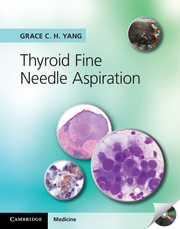Book contents
- Frontmatter
- Dedication
- Contents
- Preface
- 1 Techniques and approaches to ultrasound-guided fine needle aspiration
- 2 Nodular goiter and mimickers
- 3 Follicular neoplasm and mimickers
- 4 Hürthle cell neoplasm and mimickers
- 5 Follicular variant of papillary carcinoma
- 6 Thyroiditis and mimickers
- 7 Papillary thyroid carcinoma and variants with papillae and mimicker
- 8 Papillary thyroid carcinoma, uncommon variants, and mimicker
- 9 Clear cell and mucinous thyroid tumors
- 10 Poorly differentiated thyroid carcinoma
- 11 Anaplastic thyroid carcinoma
- 12 Medullary thyroid carcinoma
- 13 Miscellaneous benign lesions
- 14 Metastatic thyroid carcinoma
- 15 Metastatic and secondary tumors to the thyroid
- 16 Ancillary tests
- Index to case histories
- Index to ultrasound and Doppler images
- General index
- References
8 - Papillary thyroid carcinoma, uncommon variants, and mimicker
Published online by Cambridge University Press: 05 September 2014
- Frontmatter
- Dedication
- Contents
- Preface
- 1 Techniques and approaches to ultrasound-guided fine needle aspiration
- 2 Nodular goiter and mimickers
- 3 Follicular neoplasm and mimickers
- 4 Hürthle cell neoplasm and mimickers
- 5 Follicular variant of papillary carcinoma
- 6 Thyroiditis and mimickers
- 7 Papillary thyroid carcinoma and variants with papillae and mimicker
- 8 Papillary thyroid carcinoma, uncommon variants, and mimicker
- 9 Clear cell and mucinous thyroid tumors
- 10 Poorly differentiated thyroid carcinoma
- 11 Anaplastic thyroid carcinoma
- 12 Medullary thyroid carcinoma
- 13 Miscellaneous benign lesions
- 14 Metastatic thyroid carcinoma
- 15 Metastatic and secondary tumors to the thyroid
- 16 Ancillary tests
- Index to case histories
- Index to ultrasound and Doppler images
- General index
- References
Summary
This chapter describes the uncommon variants of papillary thyroid carcinoma, including tall cell, columnar cell, solid, and cribriform-morular variants, as well as a nuclear mimicker, hyalinizing trabecular tumor.
Tall cell variant
In 1976 Hawk and Hazard described a variant of papillary thyroid carcinoma that was characterized by neoplastic cells three times as tall as they were wide. With an incidence ranging from 4% to 17%, tall cell variant is the most common of the aggressive subtypes of papillary thyroid carcinoma and has the distinction of the highest BRAF mutation (60–80%) of all the variants in papillary thyroid carcinoma. This variant is composed of tall cells with abundant eosinophilic granular cytoplasm in infiltrative cords, trabecular or papillary pattern. Ultrastructual study demonstrated that the granularity of the cytoplasm of tall cell variant is due to mitochondria. There is disagreement regarding the height/width ratio to define tall cells and the percentage of tall cells required to diagnose tall cell variant. Recently, Ghossein and LiVolsi lowered the height/width ratio to 2–3: 1 or higher, and the tall cell component to 50% or more. Tall cell variant may be underdiagnosed by general pathologists. In a study from Memorial Sloan Kettering Cancer Center, 12% of classic papillary carcinoma were reclassified as tall cell variant when carefully scrutinized for the features. Even without extrathyroid extension, tall cell variant was shown to have a more aggressive behavior than classical papillary carcinoma, independent of age, gender, and tumor size. Anecdotal incident of papillary microcarcinoma of tall cell variant associated with pleural and pulmonary metastasis was reported. The aggressive behavior of tall cell variant is postulated as relating to the high expression of Muc1 and collagenase type IV. The former promotes cell dissociation and oncogenic promotion, and the latter degrades type IV collagen of the basement membrane, resulting in invasiveness and the potential for metastasis. In addition, tall cell variant has a higher prevalence of BRAF mutations than classical papillary carcinoma. Tall cell variant is overrepresented in papillary thyroid carcinomas that are refractory to radioactive iodine therapy, and BRAF-targeted therapy may benefit this group of patients.
- Type
- Chapter
- Information
- Thyroid Fine Needle Aspiration , pp. 308 - 335Publisher: Cambridge University PressPrint publication year: 2013

